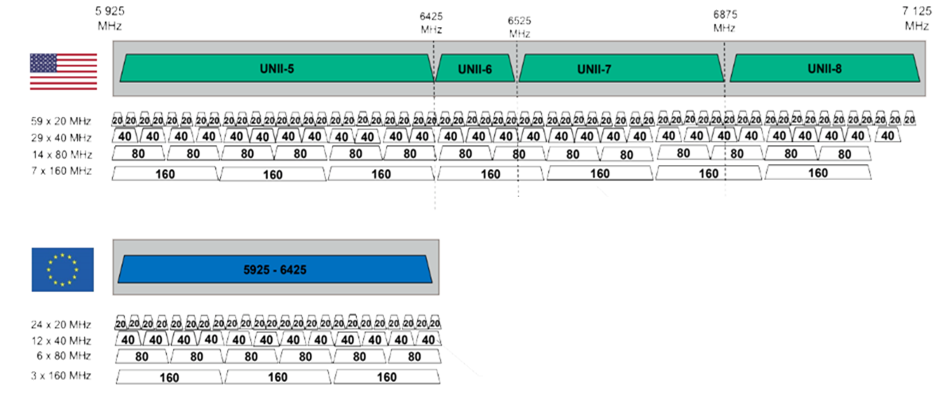In recent years, there has been a lot of focus on the use of 5G as the optimum wireless solution for low latency use cases, particularly in the most demanding Ultra Reliable Low Latency Communications (URLCC) type applications. However, the introduction of Wi-Fi 6E over the next two to three years may level the playing field and provide an alternative solution.
Although Wi-Fi is a good solution for many general enterprise applications, the technology suffers from a number of disadvantages, particularly when deployed in congested environments and in demanding industrial settings. These include poor data throughputs, variable latency, signal loss during handover between access points (APs), etc. As a result, many enterprises have been looking to deploy 4G LTE private networks (with a migration path to 5G) which overcome many of the limitations of current Wi-Fi.
However, the introduction of Wi-Fi 6 (802.11ax) represents a significant improvement over previous Wi-Fi generations such as Wi-Fi 4 (802.11n) and Wi-Fi 5 (802,11ac) and together with the introduction of Wi-Fi 6E is expected to provide Wi-Fi with performance characteristics on a par with 4G LTE and 5G NR making them even suitable for URLLC applications.
Wi-Fi 6E in the 6 GHz band
Wi-Fi 6E is designed to operate in the 6 GHz spectrum band from 5.925 GHz to 7.125 GHz (Exhibit 1). The band is currently used for licensed services, mainly outside broadcast TV electronic news gathering (ENG) services and point-to-point microwave links used by public safety organizations, utilities and wireless ISPs. Last week, the FCC sanctioned the use of the entire 1,200 MHz of the 6 GHz band for unlicensed technologies such as Wi-Fi. The EU is expected to follow suit with a similar decision later this year, while UK telecoms regulator Ofcom, is in advanced consultation over the release of the 6 GHz band in the UK.

Exhibit 1: 6 GHz frequency channel sub-bands in US and EU (© Aruba Networks)
The benefits of operating in the 6 GHz are twofold:
- Availability of more spectrum with larger channel bandwidths – in addition to 20 MHz and 40 MHz channel bandwidths, Wi-Fi 6 supports both 80 MHz and 160 MHz frequency channels. In practice, these channel bandwidths are rarely deployed as the few available 80 MHz or 160 MHz channels in the 5 GHz band are never free from interference. However, the introduction of the 6 GHz band will enable Wi-Fi 6E to run on up to seven contiguous 160 MHz-wide channels.
- Reduced congestion – only Wi-Fi 6E devices will have access to the 6 GHz (i.e. older Wi-Fi standards will be incompatible as well as Wi-Fi 6) which means that all deployments in the 6 GHz will effectively be green-field deployments and thus can be reserved for low-latency high-bandwidth applications. However, Wi-Fi 6E and other unlicensed spectrum technologies such as standalone 5G NR-U will have to share the spectrum with incumbent users and regulators around the world must address the problem of ensuring adequate protection for incumbent users in the band.
Wi-Fi 6E: Network of choice for low-latency applications?
Wi-Fi 6/6E uses many of the same technologies used in 5G such as OFDMA, MU-MIMO, advanced QAM, beam forming, etc., all of which permit more efficient use of the radio spectrum and enable both standards to achieve gigabit data throughputs. In the case of Wi-Fi 6, these are truly “game changing” technologies, and together with the use of the 6 GHz band, make Wi-Fi 6E significantly superior to previous Wi-Fi generations. This will enable Wi-Fi to compete against 5G in many of the more demanding low-latency applications currently being targeted by the cellular industry, particularly in indoor environments.
As a result, Counterpoint believes that the choice of network between Wi-Fi and 5G will no longer be “black or white” and the decision on which technology to use will depend on the precise use case and application. Enterprises will need to undertake a detailed cost-benefit analysis of 5G versus Wi-Fi for each application, which should include a compatibility assessment with existing IT infrastructure.
5G is a very flexible and robust technology which can be used in an increasing number of spectrum bands. It will clearly be the de facto network of choice for large scale deployments as it provides uniform macro coverage and also where excellent mobile coverage is required such as in the tracking of assets, vehicles, etc..
However, Wi-Fi is ubiquitous and will remain a more cost-effective solution than cellular in the workplace as well as many other local area applications. With latency levels of 2-6 milliseconds demonstrated in tests coupled with technology improvements such as guaranteed bandwidth sharing and better security, Wi-Fi 6E will be suitable for low-latency applications such as mobile AR/VR, gaming, 4k/8k video streaming, etc. As a result, Wi-Fi may well become the network of choice, not just for consumers, but also for many small, medium and even some large enterprises rather than cellular-based private networks.

